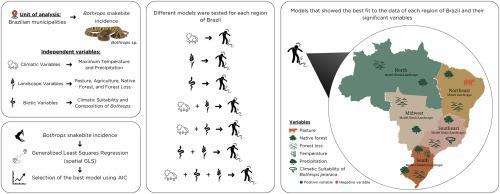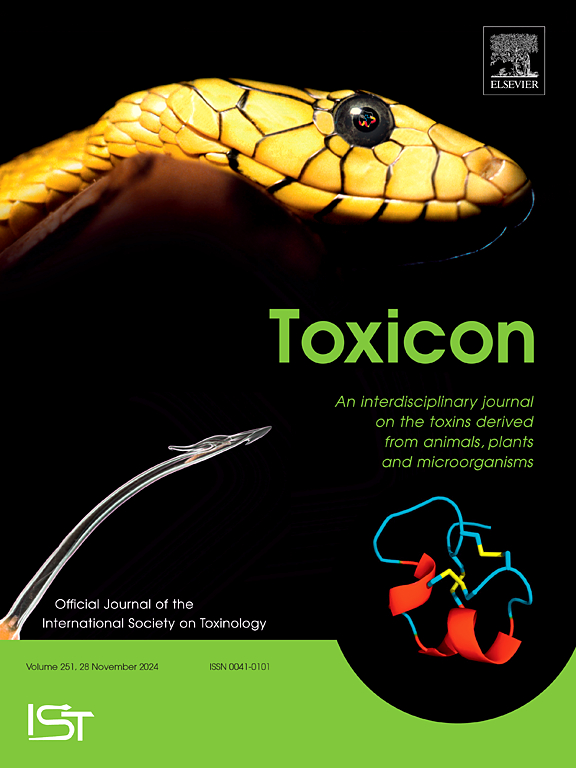预测巴西全国两栖动物蛇咬伤发病率的驱动因素:空间分析
IF 2.4
4区 医学
Q2 PHARMACOLOGY & PHARMACY
引用次数: 0
摘要
被蛇咬伤对全球公共卫生构成重大挑战,每年有数百万人受到影响,并可能导致并发症,造成死亡。巴西是受蛇咬伤影响最严重的国家之一,其中大部分咬伤都是由两栖类蛇造成的。本研究旨在确定巴西不同地区蛇咬伤发生率的决定因素。研究采用了城市分类数据,以蛇咬伤发生率为因变量,开展了一项生态学研究。研究期间为 2015 年至 2021 年。我们为两栖类物种构建了物种分布模型(SDM),并收集了巴西各市的降水、径流、最高和最低气温、原始森林、历史森林损失、农业和牧场等信息。利用这些数据来评估蛇咬伤发生率与生物、气候和景观因素之间的关联。数据采用广义最小二乘法(GLS)回归进行分析。SDM表现出良好的性能。在研究期间,平均每年每 10 万居民中的蛇咬伤发生率从零到 428.89 不等,具体取决于各个城市。较高的发病率主要集中在该国北部地区的城市。在这项研究中,我们发现在全国范围内,原生森林广布的地区和森林覆盖率曾大幅下降的地区蛇咬伤发病率较高。此外,在巴西南部和东南部,气温和降水量较高的地区,以及气候更适合B. jararaca物种的地区,蛇咬伤发病率也分别显著较高。这些关联可能与蛇的数量增加、行为活跃以及在这些地区从事有利于人蛇接触的活动有关。这项研究的结果有助于改善巴西针对这一公共卫生问题的预防和控制策略。本文章由计算机程序翻译,如有差异,请以英文原文为准。

Predicting the drivers of Bothrops snakebite incidence across Brazil: A Spatial Analysis
Snakebite envenoming poses a significant public health challenge on a global basis, affecting millions of people annually and leading to complications that may result in fatalities. Brazil stands as one of the countries most impacted by snakebite envenoming, with snakes of the Bothrops genus being responsible for most bites. The current study aimed to identify the determinants of Bothrops snakebite incidence across different regions of Brazil. An ecological study was conducted using municipality-aggregated data, with snakebite incidence as the dependent variable. The study period comprised the years 2015–2021. We constructed Species Distribution Models (SDMs) for Bothrops species, and information was collected on precipitation, runoff, maximum and minimum temperatures, native forest, historical forest loss, agriculture, and pasture in each Brazilian municipality. These data were employed to assess the association between snakebite incidence and biotic, climatic, and landscape factors. The data were analyzed using Generalized Least Squares (GLS) regression. The SDMs demonstrated good performance. The average annual snakebite incidence during the study period ranged from zero to 428.89 per 100,000 inhabitants, depending on the municipality. Higher incidence rates were concentrated primarily in municipalities in the northern region of the country. In this study, we found that nationwide, areas with extensive native forests and those that have historically experienced significant loss of forest cover exhibited higher snakebite incidence rates. Additionally, areas with higher temperatures and precipitation levels, as well as greater climatic suitability for the species B. jararaca, showed significantly higher snakebite incidence rates in the South and Southeast of Brazil, respectively. These associations may be linked to increased snake abundance and active behavior, as well as to engagement in activities favoring human-snake contact in these areas. The findings of this study can contribute to the improvement of prevention and control strategies for this public health issue in Brazil.
求助全文
通过发布文献求助,成功后即可免费获取论文全文。
去求助
来源期刊

Toxicon
医学-毒理学
CiteScore
4.80
自引率
10.70%
发文量
358
审稿时长
68 days
期刊介绍:
Toxicon has an open access mirror Toxicon: X, sharing the same aims and scope, editorial team, submission system and rigorous peer review. An introductory offer Toxicon: X - full waiver of the Open Access fee.
Toxicon''s "aims and scope" are to publish:
-articles containing the results of original research on problems related to toxins derived from animals, plants and microorganisms
-papers on novel findings related to the chemical, pharmacological, toxicological, and immunological properties of natural toxins
-molecular biological studies of toxins and other genes from poisonous and venomous organisms that advance understanding of the role or function of toxins
-clinical observations on poisoning and envenoming where a new therapeutic principle has been proposed or a decidedly superior clinical result has been obtained.
-material on the use of toxins as tools in studying biological processes and material on subjects related to venom and antivenom problems.
-articles on the translational application of toxins, for example as drugs and insecticides
-epidemiological studies on envenoming or poisoning, so long as they highlight a previously unrecognised medical problem or provide insight into the prevention or medical treatment of envenoming or poisoning. Retrospective surveys of hospital records, especially those lacking species identification, will not be considered for publication. Properly designed prospective community-based surveys are strongly encouraged.
-articles describing well-known activities of venoms, such as antibacterial, anticancer, and analgesic activities of arachnid venoms, without any attempt to define the mechanism of action or purify the active component, will not be considered for publication in Toxicon.
-review articles on problems related to toxinology.
To encourage the exchange of ideas, sections of the journal may be devoted to Short Communications, Letters to the Editor and activities of the affiliated societies.
 求助内容:
求助内容: 应助结果提醒方式:
应助结果提醒方式:


